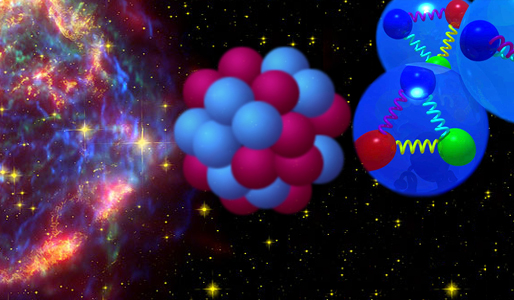Notes 2: Difference between revisions
| Line 9: | Line 9: | ||
Elements are arranged in the periodic table by order of the atomic number (Z, the number of protons in the nucleus). The atomic mass of an element is A, where A=Z+N. The radius of the nucleus is proportional to the cube root of the mass number | Elements are arranged in the periodic table by order of the atomic number (Z, the number of protons in the nucleus). The atomic mass of an element is A, where A=Z+N. The radius of the nucleus is proportional to the cube root of the mass number | ||
:<math> R=R_{0}A^{1 | :<math> R=R_{0}A^{\frac{1}{3}} | ||
</math> | |||
:<math> | |||
X_{i} = \frac{n_i}{\sum_j n_j} \, | |||
</math> | </math> | ||
Revision as of 11:51, 24 January 2011
Nuclear Astrophysics is a combination of nuclear physics and astrophysics. Nuclear physics is the study of atomic nuclei, their composition and their interactions, while astrophysics aims at studying galactic objects such as stars and galaxies. Nuclear astrophysics delves into the questions of where and when the elements were created and how nuclear reactions drive cosmic events.
The Nucleus
Atomic nuclei sizes are on the scale of meters and form the (relatively) small centers of atoms while carrying most of the mass. The basic constituents of atomic nuclei are protons (Z) and neutrons (N). Protons and neutrons are fermions (particles with half-integral spin, obey Fermi-Dirac statistics, obey the pauli exclusion princile) comprised of three quarks each, fundamental particles on a size scale of . The relevant interactions on this size/mass scale are the electro-weak and strong forces.
Elements are arranged in the periodic table by order of the atomic number (Z, the number of protons in the nucleus). The atomic mass of an element is A, where A=Z+N. The radius of the nucleus is proportional to the cube root of the mass number
The strong force (SF) (also known as the Nutclear force) is a short range force that dies off after a few femto-meters (3 x 10^-15 m) (in other words, the strong force is only relevant in the nucleus of an atom) and acts on color and charge. It is 100 times stonger than EM but many many orders of magintude stronger than the other 2 forces, gravity and the weak force. The SF mediates interaction between quarks, gluons, and anti-quarks. The gluons are the exchange particles, gluons being spin 1 particles existing only inside hadrons. Hadrons feel the strong force indirectly (or they feel the residual effect of the SF). Hadrons are baryons (made of three quarks, i.e. the proton and neutron) and mesons (a quark and anti-quark pair). The strong force binds nucleons (protons and neutrons) together in the nucleus. It is charge independent, but dependent on spin orientation.
The range of the force determined by the uncertainty principle is R=Hbar/(mc) where m is the mass of the virtual pion.
The weak force acts on flavor. Quarks and leptons experience this force. The W+, W-, and Z0 particles are the mediating particles. Like the strong force, the stregnth dies off rabpidly with distance.
Definitions for Abundance
The particle abundance of isotope is defined as
where is the the number density of particle , and the sum is taken over all isotopes present. It is also useful to define a relative particle abundance, which is set logarithmically and normalized to the abundance of hydrogen:
The mass fraction is the fraction of total mass in the sample constituted by species :
- ( Note that and )
Denoting the mass per baryon, as
allows us to define the particle's number density by the density of the sample and this baryon fraction,
Another useful quantity is the average mass number, or mean molecular weight, defined by
The electron abundance
- , which can also be written as
is the ratio of protons to nucleons in the sample, and similarly to nuclei, the electron number density is found by

















